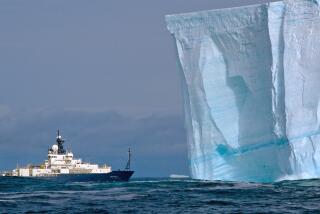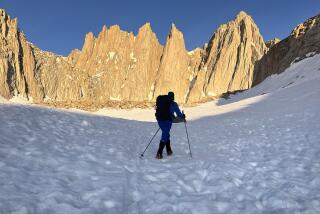Couple Taking Dreams to the Ends of the Earth
- Share via
If all goes well for them, Tom and Tina Sjogren should be sitting on top of the world sometime within the next week.
Of course, seldom does all go well during an unsupported trek to the North Pole, which is why only a handful of adventurers reach it each year, and the Sjogrens’ historic expedition might have to be abandoned at any moment.
On Thursday, for instance, the New York-based couple, attempting to become the first people to cross both of the earth’s poles one almost right after the other, awoke to temperatures below zero, a howling wind and foggy, whiteout conditions. Rest was not an option.
“Our supplies are so limited,” said Tina, who with her husband of 18 years began the 483-mile trek to the North Pole from Ward Hunt Island, Canada, on March 17. “We only have food and gas for another six days, so we have to head out in this. So we’re going to put on facemasks to protect our faces and put on all the clothes we need and just head out into it.”
Traversing a constantly shifting frozen landscape, they are unsupported by dogs, sails or air drops. They drag their supplies behind them on sleds that at expedition’s start weighed 350 pounds. Skiing across open ice or using their sleds to paddle leads--channels of nearly frozen water--they have also tackled ice ridges 30 feet tall and 150 feet wide, all the while battling mostly inclement weather and temperatures as low as minus-60 degrees.
“What worries me is, whenever there’s a wind, a lot of things happen to the ice and the area we passed yesterday was really nasty. The water was bobbing up and down,” she said, “... also the wind, together with the strong current, is actually carrying us away in the leads. So it’s pretty bad right now.”
As they have discovered, however, it could be a lot worse.
Last week, more than 200 miles from land, Tom came frighteningly close to suffering a broken neck and Tina nearly drowned.
Tina was ahead when Tom, passing over a ridge, slipped and fell onto his head.
Finding her husband nearly unconscious, Tina feared that he might be paralyzed. She determined that he was not, but their ordeal was far from over. Moving Tom onto a solid piece of ice, she put up a tent and tucked him into a sleeping bag “because he was getting hypothermic.” Then she went for his sled.
“But because I was in a hurry and I was a little bit stressed,” she said, “I didn’t care to put on my skis and I fell right through into the ocean because I couldn’t see that there was black ice because it was covered with snow.”
What had happened, she said, took a few seconds to register. And then suddenly popped into her head thoughts of an adventurer who had drowned in those very waters a year ago. Not wearing a drysuit, she felt herself getting rapidly colder.
“I said to myself, ‘I have to get out of here,’” she said.
On one side of the lead, however, the edge was too steep to climb out of the water. On the other, the ice was so thin that every time she heaved herself out of the water it broke away. She felt herself growing weaker.
“You are very, very cold and suddenly it’s like somebody opens you and blood comes out,” she said. “You just totally lose all strength.”
Not lost, however, was her will.
Finally, her hands nearly numb, she lifted herself onto the ice.
“If I don’t do this, I’m going to die,” she said, explaining how she’d saved herself. “You get that kind of power sometimes when you really must.”
The next day, Tina phoned a doctor who guided her to construct a makeshift neck stabilizer for Tom from a piece of foam mattress, and the couple were soon moving again. They were back into their regular routine, ingesting 5,000 to 6,000 calories a day of freeze-dried food to maintain their strength and energy but still losing weight, their faces covered with cold lumps and their knees, legs and backs crying for mercy.
This is their third expedition in 18 months. After aborting their first attempt to reach the South Pole early last year because of illness and logistical problems after 62 days, the Sjogrens, both 42, started another attempt Nov. 29, completing the 1,250-mile Polar skiing journey to the earth’s southernmost point Feb. 2.
The successful quest made Tina the first woman to have reached two of what adventurers call the three poles, the Sjogrens having scaled Mt. Everest in 1999.
Each lost about 40 pounds and contracted frostbite while dragging their supply-weighted sleds across Antarctica, but six weeks later, after regaining about 30 pounds each, they were back on their skis, trekking toward the North Pole.
It was enough to make Tom, a Swede, jokingly announce to his Czech wife one day over lunch early in the expedition, as recounted later in the couple’s daily dispatches at www.thepoles.com, “I’ll place a personals ad in classifieds: Calm, simple guy looking for a like-minded girl for uncomplicated, serene life and candle-light dinners.”
Communicating to the world via computers around their waists and monitors built into their eyepieces, the Sjogrens have laboriously and painstakingly made their way toward the North Pole in their attempt to become only the fourth and fifth persons to achieve the so-called “Triple Crown” of adventuring.
Full-time adventurers who own a household-tissue delivery service in Sweden, the couple have crossed jungles, sailed oceans and spent several years climbing in the Himalayas. Their trek toward the North Pole, they say, is “by far” the most difficult adventure they’ve attempted, Tom saying the trip combines the most arduous aspects of the Everest climb and the Antarctica journey.
It has brought the Sjogrens closer, Tina said, not only to an adventuring milestone and the northernmost point on the globe but also to each other.
“We get along very, very well because we have to,” she said. “This is so strenuous on you physically and mentally. ... To start fighting in this kind of situation puts an unbearable strain on us, so we can’t do that. But it has taken some time to get to this point.”
Staying positive through it all, Tom said, is a constant battle.
“That’s the most difficult part in an expedition,” he said. “Your whole body wants to quit all the time. Your mind wants to quit.
“You know, why am I doing this? It’s not really necessary. Let me go back home and have a nice coffee in SoHo instead. So you have to train yourself to not quit--even when you have good reason to quit.”
More obstacles could lie ahead.
An open patch of ocean several miles wide could end their pursuit of the North Pole, and a new moon is due this weekend, promising higher tides and threatening to break up the ice and open more leads. Constructing a catamaran out of their sleds is a possibility, but still they might run out of time before reaching their unmarked destination.
“Because we are unsupported, we must go slowly,” Tina said. “That leaves us here very late in the season and to be this close to the North Pole this late is not a very good thing because this is the time when everything melts.
“If we had been here one month earlier, everything would have been frozen over. It would have been totally different. But now everything is melting around us.”
They have no idea what awaits them at the North Pole, in the middle of the Arctic Ocean, because, as Tina said, “We’ve never been there before.”
They suspect it will be ice.
They pray it’s not water.
More to Read
Sign up for The Wild
We’ll help you find the best places to hike, bike and run, as well as the perfect silent spots for meditation and yoga.
You may occasionally receive promotional content from the Los Angeles Times.






